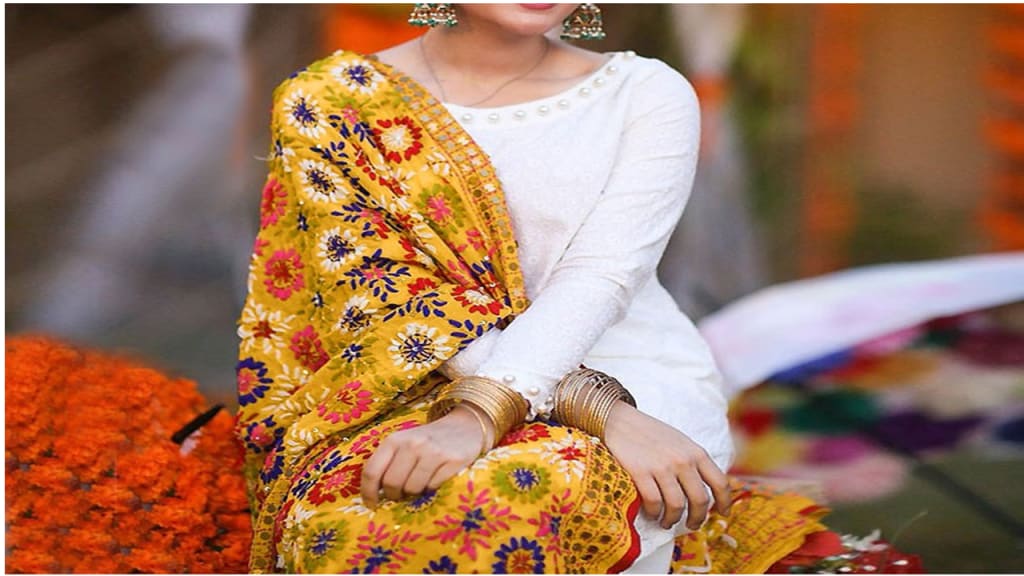The Significance of Bridal Attire: Unraveling the Essence of Shalwar, Kameez, and Dupatta
Wedding Rituals in Punjabi Society

Introduction:
Weddings hold a special place in every culture, symbolizing the union of two souls embarking on a lifelong journey together. Among the many elements that contribute to the beauty and grandeur of a wedding ceremony, bridal attire undoubtedly stands out as a testament to tradition, elegance, and cultural heritage. In many regions, the bridal ensemble comprises three essential components: the shalwar, kameez, and dupatta. This article aims to explore the theory behind these precious garments and shed light on their historical, cultural, and aesthetic significance.
I. The Origins and Evolution of Bridal Attire:
The history of bridal attire is intertwined with the rich tapestry of human civilization, reflecting the influence of various cultures, customs, and social norms. The concept of the shalwar, kameez, and dupatta can be traced back to ancient times when the adornment of brides played a crucial role in marking their transition into marital life. Over the centuries, these garments have evolved, adapting to changing fashion trends while retaining their core essence.
II. The Symbolism and Cultural Significance:
A. The Shalwar:
The shalwar, a loose-fitting trouser, embodies comfort, modesty, and practicality. Its wide range of designs, colors, and embellishments reflects the diversity of cultures and traditions across different regions. By wearing the shalwar, the bride honors the customs and values of her community, emphasizing the importance of humility and simplicity in her new role as a wife.
B. The Kameez:
The kameez, a long tunic or shirt, serves as the centerpiece of the bridal ensemble. It is crafted with intricate detailing, embroidery, and embellishments, showcasing the craftsmanship and artistry of skilled artisans. The kameez not only enhances the bride's beauty but also represents femininity, grace, and elegance. It acts as a canvas for cultural motifs and designs, allowing the bride to express her individuality while staying rooted in tradition.
C. The Dupatta:
The dupatta, a long scarf or veil, completes the bridal attire, adding an ethereal touch to the ensemble. It holds deep cultural and symbolic significance across various communities. The dupatta serves as a symbol of modesty, purity, and protection. It can be draped in different styles, each reflecting regional customs and traditions. Furthermore, the dupatta often becomes a cherished heirloom, passed down through generations, carrying the legacy of love, blessings, and familial bonds.
III. Regional Variations and Unifying Threads:
While the shalwar, kameez, and dupatta form the foundation of bridal attire in many regions, each locality adds its own distinct flavor and style to these garments. From the vibrant hues and intricate embroidery of Pakistani bridal wear to the opulence and regal embellishments of Indian bridal outfits, the diversity is mesmerizing. Yet, despite these regional variations, the underlying essence remains the same – to celebrate love, honor tradition, and create a lasting memory.
IV. Contemporary Influences and Adaptations:
As society evolves and fashion trends continue to evolve, bridal attire has also undergone transformations to keep pace with the modern era. Designers now experiment with fusion styles, blending traditional elements with contemporary aesthetics. Bridal ensembles featuring unconventional color palettes, innovative silhouettes, and fusion accessories have become increasingly popular, allowing brides to express their individuality while respecting their cultural heritage.
Conclusion:
In the realm of bridal fashion, the shalwar, kameez, and dupatta hold a special place as timeless symbols of tradition, culture, and love. These three components of bridal attire, while distinctive in their own right, come together harmoniously to create a mesmerizing ensemble. From the moment a bride dons her precious bridal clothes, she embodies the essence of her culture, carries the weight of centuries-old customs, and embarks on a new chapter filled with joy, hope, and the promise of a lifelong partnership. The shalwar, kameez, and dupatta stand as a testament to the enduring power of tradition and the beauty of cultural diversity, weaving together threads of the past, present, and future.
About the Creator
Dr. Amjad Ali Bhatti
Dr. Amjad Ali Bhatti is a multifaceted individual who has made significant contributions in the fields of research, translation, literature, and social activism.
Enjoyed the story? Support the Creator.
Subscribe for free to receive all their stories in your feed. You could also pledge your support or give them a one-off tip, letting them know you appreciate their work.






Comments
There are no comments for this story
Be the first to respond and start the conversation.